Diamond DA40 Diamond Star
| DA40 Diamond Star | |
|---|---|
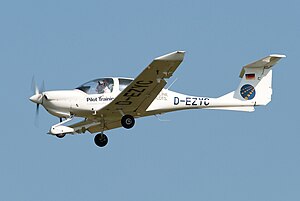
| |
| Role | Light aircraft |
| Manufacturer | Diamond Aircraft Industries |
| First flight | 5 November 1997 |
| Status | In production |
| Produced | 1997–present |
| Number built | 2,200 (December 2020) |
| Developed from | Diamond DA20 |

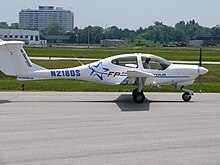
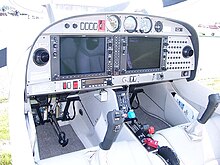
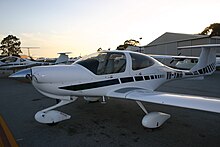
TheDiamond DA40 Diamond Staris anAustrianfour-seat, single-engine,light aircraftconstructed fromcomposite materials.Built in both Austria and Canada, it was developed as a four-seat version of the earlierDA20byDiamond Aircraft Industries.
By the end of December 2020, 2,200 DA40s had been delivered, including 500 NG models.[1]
Development
[edit]Based on the success of the earlierDV20/DA20two-seat aircraft, the company designed a four-seat variant, the DA40 Diamond Star. TheRotax 914-powered prototype DA40-V1, registered OE-VPC, first flew on 5 November 1997 and was followed by a second prototype DA40-V2 (registered OE-VPE) which was powered by a Continental IO-240. In 1998 a third prototype DA40-V3 flew powered by a Lycoming IO-360 engine. Four more test aircraft were produced followed by the first production aircraft in 2000. JAR23 certification of the IO-360 production variant was obtained in October 2000. In 2002 the production of the Lycoming-engined variant was moved to Canada and the Austrian factory concentrated ondiesel-enginedvariants. The first flight of the Diesel DA40D was made on 28 November 2002.
In late 2006, the XL and FP models replaced the DA40-180. The FP replaced the fixed pitch propeller version of the 180 and the XL replaced theconstant speed propellerversion. The major difference between the new models and the 180 is the higher maximum cruise speeds. The DA40-XL is approximately four knots faster than the preceding DA40-180/G1000 with the two-bladeHartzellpropeller and the "Speed Gear" option. The XL's speed increase is mostly due to the Powerflow exhaust system.[clarification needed]
In the last half of 2007 the company updated the DA40 line by introducing the XLS and CS versions and eliminated the FP model. The XLS is the deluxe version, with the integration of some options into the standard offering including a Powerflow tuned exhaust, WAAS-capable G1000, GDL69 datalink, and TAS traffic alert system. The CS is the budget version, with fewer standard features.[2]
Both CS and XLS versions of the DA40 use the Lycoming IO-360-M1A fuel injected engine. The major difference is the choice of propeller, with the CS using a Hartzell two-blade aluminum constant speed prop and the XLS using an MT composite three-blade unit.[3][4]
Capacity is available for up to 1,000 aircraft a year to be produced with certification by theEuropean Aviation Safety Agencyin 2008.[5][6]
Past DA40 models were available with either traditional mechanical instruments or an optionalGarmin G1000glass cockpitsuite. Current[when?]production DA40s are built only with the Garmin G1000 as standard equipment. In April 2008, Diamond introduced the optional availability ofGarminSynthetic Vision Technology on the DA40 XLS.[7]
In October 2021, Diamond Aircraft announced an all-electrictraining variant, the eDA40, with initial flights scheduled for the second quarter of 2022 and EASA/FAA Part 23 certification expected in 2023.[8]It should fly for 90 minutes, with a fast charge for 20 minutes turnarounds and operating costs 40% lower than piston aircraft.[8]
Design
[edit]The DA40 is a four-seat low-wing cantilevermonoplanemade from composite materials. It has a fixedtricycle landing gearand aT-tail.
The DA40 has officially appeared in only three versions, the DA 40, DA 40D and DA 40F, as documented on its type certificates. The various model names that the aircraft has been sold under are marketing names and are not officially recognized by the authorities that have certified the aircraft.[3][4]
The DA40 was initially marketed as the DA40-180, powered by a fuel injectedTextron Lycoming IO-360 M1Aengine.[3][4]
The DA40-XL has a constant speed propeller and is powered by a 180 hp (130 kW)Lycoming IO-360-M1Afuel injected engine. It has a maximum cruise speed of 147 kn (272 km/h; 169 mph), burning 9.2 gallons ofAvgasper hour. Its maximumtakeoffweight is 2,535 lb (1,150 kg).[9]
The DA40-F (marketed as the "FP" ) has a fixed pitch propeller, a 180 hp (130 kW)Lycoming O-360-A4Mengine, which has acarburetorrather than fuel injection and a more basic interior, but is otherwise similar to the XL.[3][4]
The DA40-TDI uses aThielert"Centurion" 135 hp (101 kW)diesel engineand burns diesel orjet fuel.It has a constant speed propeller andFADEC(single lever) engine control. The Diesel DA40D is not certified in theUS.[3][4][10]
Efforts to increase the DA40's cruising speed centered on the propeller and wheel spats. The wheel fairing streamlining was improved, a three-blade scimitar-type constant speed propeller was incorporated and the Powerflow exhaust system from the XL was retained. The canopy contour was also revised, with the sides being more vertical before curving into the roof, which provides more shoulder and head room.
Boarding the DA40 is via the leading edge of the wing, an unusual feature among low-wing aircraft. The aircraft's nosewheel is free-castoring and directional control whiletaxiingis by mainwheel differential braking.[11]
DA40s are produced at Diamond's aircraft factories inWiener Neustadt,Austriaand inLondon, Ontario,Canada.A joint venture has also been set up in China withShandong Bin Ao Aircraft Industriesfor production of the DA40 TDI (Diesel) inShandong Province.[12]
Operational history
[edit]The DA40 has accumulated a very low accident record, particularly with regard tostallandspinaccidents. Its overall and fatal accident rates are one-eighth that of the general aviation fleet and include no stall-related accidents. The level of safe operation is attributed to its highaspect ratiowing, lowwing loadingand benign flight characteristics. The aircraft can be trimmed full nose up, engine set to idle and it will descend at 600–1,200 feet per minute (180–370 m/min) at 48 kn (55 mph; 89 km/h) hands-off, a lower rate of descent than the competitorCirrus SR22can achieve with its airframeballistic parachutedeployed.[13]
In a 2011 analysis byAviation Consumermagazine, the DA40 was shown to have had a fatal accident rate of 0.35/100,000 hours, the lowest in US general aviation and considerably better than the market leadingCirrus SR20andSR22,which that year had a combined fatal accident rate of 1.6/100,000, despite its full aircraft parachute system. By comparison, theCessna 172had a fatal accident rate of 0.45/100,000 hours.[14]
A Chinese flying school has used its CD-135 for 13 hours per day on average.[15]
Variants
[edit]
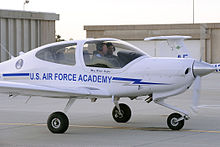
- DA40
- Initial model, powered by aTextron Lycoming IO-360 M1A180 hp (135 kW) engine and aMT PropellersMTV-12-B/180-17. Maximum gross weight is 1150 kg (2535 lb) or 1200 kg (2646 lb) with modifications installed. In increasingly refined versions marketed as the DA40-180, XL, CS and XLS.[3][4][2]
- DA40 D
- Diesel model, powered by aThielertTAE 125-01 (Centurion 1.7) or TAE 125-02-99 (Centurion 2.0) engine of 135 hp (101 kW) andMT PropellersMTV-6-A/187-129. Maximum gross weight is 1150 kg (2535 lb). Marketed primarily in Europe, although certified in Canada and Australia as well, as the DA40 TDI.[3][4][10]
- DA40 F
- Fixed pitch propeller model, powered byTextron Lycoming O-360-A4Mand aSensenich6EM8S10-0-63 or aMT-PropellerMT 188R135-4G propeller. Maximum gross weight is 1150 kg (2535 lb). Marketed as the DA40 FP. This model is no longer offered.[3][4]
- DA40 NG
- Latest model, offered in select markets only (DA40 model is still offered in other markets), powered by anAustro Engine AE 300165.6 hp (123.5 kW) running on JET A-1 fuel.EASAcertified April 2010. By December 2020, 500 NG models had been produced.[1][16][17][18][19]
- T-52A
- Military trainer version, 20 acquired in 2009 and used by the557th Flying Training SquadronatUnited States Air Force Academy.[20]The type was replaced in 2012 with theCirrus SR20-based T-53A.[21]
- DA40 XLT
- Version introduced in April 2013 with an upgraded interior, including sun-resistant deluxe leather seats, improved lumbar contours, sun visors, more cup holders and improved storage for hand-held devices.[22]
- DA40 Tundra Star
- Version with strengthened landing gear, larger tires for operation from unimproved surfaces and a 168 hp (125 kW)Austro AE300diesel engine that burns jet fuel.[23][24]
- eDA40
- All-electrictraining variant, announced in October 2021, initially targeting a 2022 first flight and a 2023 certification, with 90 minute endurance.[8]Charging can be accomplished in 20 minutes but certification could slip to early 2024, and the 90-minute endurance goal could be reached only as battery technology allows.[25]The first flight actually occurred on 20 July 2023. The company expects it to be the first EASA/FAA Part 23 certified electric aircraft.[26]
Operators
[edit]Civil
[edit]The aircraft is popular with flying schools and is operated by private individuals and companies.

At the December 2018MEBAAshow, theSaudi ArabianNational Company of Aviation-CAE Inc.Training Centre inDammamordered 60 single-engine DA40 NG and twin-engine DA42-VI, to be delivered over five years, with Garmin G1000 NXi glass panels and diesel engines.[27]
Military
[edit]- Royal Australian Air Force– 8 leased from local firm for use with theAustralian Air Force Cadets[28]
- Austrian Air Force– 2 in service with 2 more on order.[29]
- Bangladesh Army– 4 in service with 2 more on order.[30]
- Bolivian Air Force– 9 for basic flight training.[31]
- Ecuadorian Air Force– 12[32][33]
- Academy "Cosme Rennella Barbatto"
- Jamaica Defence Force Air Wing– 4 order.[36][37]
Specifications (2007 model Diamond DA40 XL Diamond Star)
[edit]Data fromDiamond Aircraft website[40]
General characteristics
- Crew:one
- Capacity:three passengers
- Length:8.1 m (26 ft 7 in)
- Wingspan:11.9 m (39 ft 1 in)
- Height:1.98 m (6 ft 6 in)
- Wing area:13.5 m2(145 sq ft)
- Airfoil:Wortmann FX 63-137[41]
- Empty weight:795 kg (1,753 lb)
- Gross weight:1,198 kg (2,641 lb)
- Powerplant:1 ×Lycoming IO-360-M1A4-cylinder air-cooled horizontally-opposed piston engine, 134 kW (180 hp)
Performance
- Cruise speed:279 km/h (173 mph, 151 kn)TAS
- Stall speed:91 km/h (57 mph, 49 kn) flaps down
- Range:1,341 km (833 mi, 724 nmi)
- Service ceiling:5,000 m (16,000 ft)
- Rate of climb:5.69 m/s (1,120 ft/min)
- Power/mass:0.110 kW/kg (0.067 hp/lb)
See also
[edit]Related development
Aircraft of comparable role, configuration, and era
- Cessna 182T Skylane
- Cirrus SR20
- Lancair Columbia
- Mooney M20
- Sling Aircraft Sling TSi
- Tecnam P2010
- Vans RV-10
References
[edit]- ^abO'Connor, Kate (30 December 2020)."Diamond Rolls Out 500th DA40 NG".AVweb.Archivedfrom the original on 1 January 2021.Retrieved1 January2021.
- ^abDiamond Aircraft Industries."DA40 Diamond Star XLS and CS".diamondaircraft.Archived fromthe originalon 26 October 2011.Retrieved11 September2008.
- ^abcdefghTransport Canada(24 June 2020)."Type Certificate Data Sheet A-224 Issue 10".Archivedfrom the original on 21 March 2023.Retrieved21 March2023.
- ^abcdefghFederal Aviation Administration(14 July 2021)."TYPE CERTIFICATE DATA SHEET NO. A47CE Revision 16".Archivedfrom the original on 21 March 2023.Retrieved21 March2023.
- ^"News Breaks",Aviation Week & Space Technology,1 January 2007.
- ^Mark Phelps. "Fear and Loathing for China".Sport Aviation:100.
- ^Diamond Aircraft (April 2008)."Diamond Aircraft introduces Synthetic Vision on DA40 Diamond Stars".Archived fromthe originalon 21 January 2013.Retrieved11 June2008.
- ^abc"Diamond Aircraft announces future All-Electric Trainer and partnership with Electric Power Systems"(Press release). Diamond Aircraft. 12 October 2021.
- ^"DA40 XL Fact Sheet"(PDF).Archived fromthe original(PDF)on 5 February 2012.Retrieved24 November2013.
- ^ab"DA40 Diamond Star Innovation in Motion".Diamond Aircraft Industries.Archived fromthe originalon 12 October 2008.Retrieved11 September2008.
- ^Flying the Diamond Star XLS,Flying,Vol. 135., No. 5, May 2008, p. 64.
- ^"Aviation Week & Space Technology". 14 October 2013: 60.
{{cite journal}}:Cite journal requires|journal=(help) - ^Bertorelli, Paul (30 October 2011)."Fun With Parachute Mode".AVweb.Retrieved31 October2011.
- ^"Aviation Consumer: Cirrus Safety Record Just Average".AVweb.20 December 2011.Retrieved22 December2011.
- ^Pope, Stephen (2 April 2015)."Diesel Trainer Market Booming in China".Flying.Retrieved9 April2015.
- ^EASA(5 April 2016)."Type Certificate Data Sheet for Noise EASA.A.022 Issue 13"(PDF).easa.europa.eu.Archived(PDF)from the original on 18 January 2021.Retrieved24 May2021.
- ^EASA(22 April 2021)."Type Certificate Data Sheet EASA.IM.A.022"(PDF).easa.europa.eu.Archived(PDF)from the original on 24 May 2021.Retrieved24 May2021.
- ^"DA40 New Generation".Diamond Aircraft Industries.Archived fromthe originalon 30 May 2012.Retrieved24 May2012.
- ^"Air Flight Manual DA 40 NG"(PDF).Diamond Aircraft Industries.April 2010. Archived fromthe original(PDF)on 9 October 2022.Retrieved24 May2012.
- ^USAFA (August 2009)."557 FTS Aircraft – T-52A"(PDF).Archived fromthe original(PDF)on 16 July 2011.Retrieved6 May2010.
- ^"Academy gets 25 new trainer aircraft for $6.1M".Air Force Times.Associated Press.June 2011.Retrieved17 June2011.
- ^"Diamond Introduces DA40 XLT".Avweb. 9 April 2013.Retrieved13 April2013.
- ^"DA40 Tundra Star – Takes you places".Diamond Aircraft Industries.Archived fromthe originalon 20 November 2015.Retrieved19 November2015.
- ^"NBA A: Diamond unveils jet fuel variant of DA40 Tundra".Flightglobal.Retrieved19 November2015.
- ^Niles, Russ (28 April 2022)."Diamond Predicting 20-Minute Charge For Electric eDA40".AVweb.Retrieved30 April2022.
- ^Phelps, Mark (27 July 2023)."Diamond Aircraft's All-Electric eDA40 Completes First Flight".AVweb.Archivedfrom the original on 28 July 2023.Retrieved28 July2023.
- ^James Wynbrandt (10 December 2018)."Saudi Academy Orders 60 Diamond Trainers".AIN online.
- ^Waldron, Greg (1 March 2019)."AVALON: Canberra leases eight DA40 NGs for cadets".FlightGlobal.Melbourne.Archivedfrom the original on 1 March 2019.Retrieved1 March2019.
- ^"Neue Schulflugzeuge und Löschfahrzeuge an Truppe übergeben".bundesheer.at.Retrieved4 May2018.
- ^"Trade-Register-1971-2019.rft".Stockholm International Peace Research Institute.Retrieved11 March2020.
- ^New Basic Trainers for Bolivian Air Force, Air Forces Monthly, September 2010, p. 23
- ^Pope, Stephen (1 November 2011)."Ecuador Air Force Buys DA20s".Flying.Flyingmag.Retrieved27 August2012.
- ^"Ecuador Air Force accepts delivery of Diamond DA20 fleet".Diamond Aircraft. Archived fromthe originalon 25 May 2012.Retrieved27 August2012.
- ^"Ini Dia, Penampakan C295 Berseragam Polisi Udara".airspace-review(in Indonesian). 1 June 2018.Retrieved7 March2021.
- ^"Indonesian Airforce Impressions Part 8 / 10".dutchaviationsupport.2008.Retrieved7 March2021.
- ^Jamaica Defence Force buying new helicopters, training aircraft
- ^ncoicinnet."Diamond DA40 FP".Jdfmil.org. Archived fromthe originalon 2 April 2017.Retrieved23 December2013.
- ^"Singapore Registered Aircraft Engine Nos – Nov 2017"(PDF).caas.gov.sg.Civil Aviation Authority of Singapore.30 November 2017.Retrieved10 December2017.
- ^Doss Aviation (December 2008)."Diamond DA40 Selected For USAF Academy Powered Flight Program".Archived fromthe originalon 10 July 2011.Retrieved15 April2009.
- ^"Diamond DA40 XLS Specs and Options".Diamond Aircraft Industries.Archived fromthe originalon 13 October 2008.Retrieved11 October2008.
- ^Lednicer, David."The Incomplete Guide to Airfoil Usage".m-selig.ae.illinois.edu.Retrieved16 April2019.
